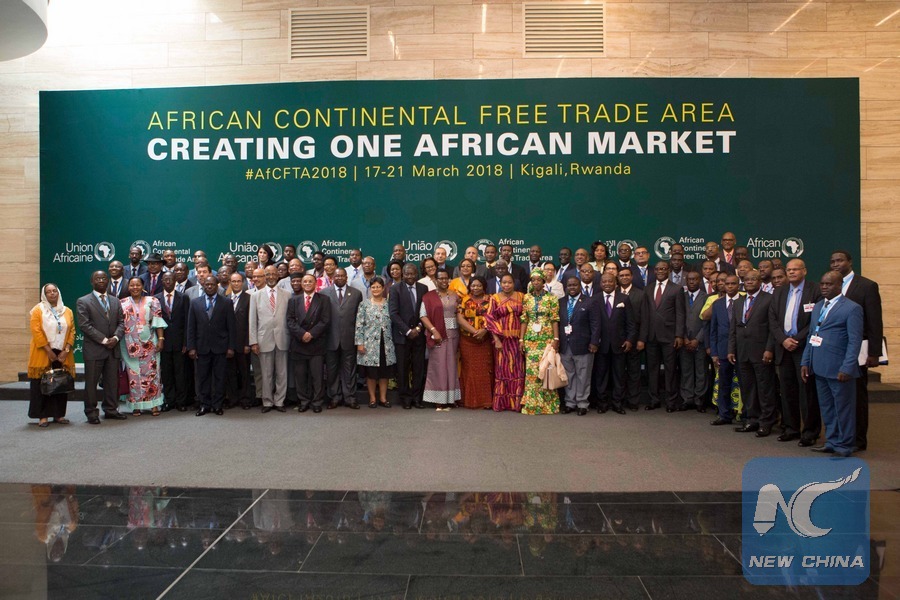Compiled by George Mangula
Over 40 African countries including Uganda appended signature to an agreement to launch the African Continental Free Trade Area (AFCFTA) in Kigali, Rwanda, on Wednesday, with the expectation that the landmark deal if ratified will boost trade within the countries.
The agreement cast in the mold of the European Union’s version was signed during the 10th Ordinary Session of African Union Heads of State summit.
The UN Economic Commission for Africa (UNECA) believes that if implemented, the agreement could increase intra-African trade by 52 percent by 2022, compared with trade levels in 2010.
That said, here’s what you need to know about the biggest trade agreement signed since the World Trade Organisation (WTO) was established.
What is AFCFTA?
African heads of government agreed to establish a continental free trade area in 2012 and started negotiations in 2015.
The agreement was signed by all 55 member states of thee African Union , bringing together 1.2 billion people with a combined gross domestic product (GDP) of more than US$2trn.
The draft agreement commits countries to removing tariffs on 90 percent of goods, with 10 percent of “sensitive items” to be phased in later.
The agreement will further liberalise services and aims to tackle the non-tariff barriers which hinder trade between African nations. Such barriers include long delays at the border and security checks along the roads.
Eventually, free movement of people and even a single currency could become part of the free trade area.
Single market for Africa!
By creating a single continental market for goods and services, the member states of the African Union hope to boost trade between African countries.
Currently intra-African trade is relatively limited. According to United Nations Commission for Trade and Development (UNCTAD), it made up only 10.2 percent of the continent’s total trade in 2010.
David Luke, coordinator of the African Trade Policy Centre at UNECA, hopes the free trade area will correct this “historical anomaly”.
“Colonialism created a situation where neighbours stopped trading with each other. The main trading route was between African countries and European countries and between African countries and the US,” he says.
Removing barriers to trade is expected to not just grow trade within the continent but also grow “the kind of trade the people need.
According to a UNECA report, between 2010 and 2015, fuels represented more than half of Africa’s exports to non-African countries, while manufactured goods were only 18 percent of exports to the rest of the world. Within Africa, 43 percent of goods traded are manufactured products.
Africa also faces the challenge of commodity prices which are volatile, making economies that rely on their export vulnerable. Moreover, officials say, the export of commodities from Africa tends to be capital- rather than labour-intensive.
“In this kind of economy, young people cannot find jobs. This is why they are trying to get to Europe and Arab countries, says a Ugandan government official who preferred to remain anonymous in this article. He adds that job creation in Africa requires production of goods that everyone consumes.
Leaders hope the free trade area will boost Africa’s competitiveness in the global market.
The challenges
Despite the signing of the agreement, some African countries are still skeptical about the document, with The Nigeria Labour Congress (NLC) labeling it a “renewed, extremely dangerous and radioactive neo-liberal policy initiative” .This shows that not country is satisfied with the deal.
Some countries fear that the benefits of the free trade area could be unevenly distributed, benefiting more advanced countries on the continent such as South Africa, Egypt.
Some analysts say the treaty mainly tackles cutting tariffs, without sufficient consideration of the varying production capabilities of African countries.
“We need to pay attention to the big economies against the small economies. We need to pay attention to the dominant sectors against the weaker sectors,” says another analyst in Uganda who gave Kenya in East Africa as a dominant force compared to its neighbours who have weak economies and industries.
Other analysts are of the view that domestic policies need to be in place to assist workers and businesses when competition hits up.
With the new trade agreement African Governments, according to economists in this area, will need to develop a more skilled workforce ready to take up demands of the globalisation but also that governments at the same time create social policies for those who will lose jobs due to increased competition.
Three documents were signed including the establishment of Continental Free Trade Area, the Protocol of the Free Movement of People and the Kigali Declaration.
What happens next?
AfCFTA will come into force after it has been ratified by either 15 or 22 countries – a number that has yet to be agreed on.
A second phase of negotiations will be held later to cover investment, competition policy and intellectual property. But there are other details that still need to be ironed out; countries will need to submit which products they consider “sensitive”, thus exempting them from the tariff cut for now. And the African Union Commission will need to establish a secretariat to preside over the agreement.







